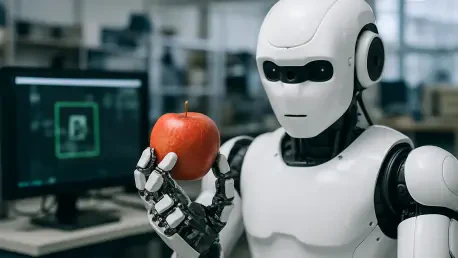In an era where technology is reshaping industries at an unprecedented pace, the integration of artificial intelligence with image detection stands out as a transformative force in robotics and automation, enabling machines to perceive and interpret their surroundings with a level of precision that rivals human vision. This cutting-edge development opens up new possibilities for efficiency and innovation across various sectors. From manufacturing floors to sprawling agricultural fields, AI-driven image detection is empowering robots to execute tasks with remarkable accuracy, fundamentally altering how industries operate. By leveraging advanced computer vision and neural networks, these systems can analyze visual data in real time, making split-second decisions that enhance safety and productivity. This technological leap is not just a trend but a cornerstone of modern automation, promising to redefine operational capabilities across diverse sectors. As industries embrace this paradigm shift, the impact of AI image detection continues to grow, setting the stage for a future where machines and humans collaborate seamlessly.
Transforming Industrial Operations with Visual Intelligence
The manufacturing sector has witnessed a profound transformation thanks to AI image detection, particularly in the realm of quality control. This technology equips robots with the ability to scrutinize products for defects at a microscopic level, identifying flaws that might escape even the most trained human eye. Such precision drastically reduces waste, ensuring that only items meeting the highest standards reach the market. Beyond mere defect detection, AI systems can adapt to varying production conditions, learning from each inspection to improve over time. This adaptability not only elevates product quality but also cuts down on costly recalls and rework. As a result, manufacturers can maintain a competitive edge by delivering consistent excellence while optimizing resources. The ripple effect of this capability extends to consumer trust, as companies build reputations for reliability through technology-driven oversight, fundamentally enhancing the entire production lifecycle.
In warehouse logistics, AI image detection is equally revolutionary, streamlining operations with unprecedented efficiency. Robots equipped with advanced vision systems can navigate complex environments, accurately identifying and retrieving items from vast inventories. This capability minimizes errors in order fulfillment, ensuring that the right products are delivered promptly. Furthermore, these systems optimize space utilization by dynamically adjusting to inventory changes, a task that traditional methods struggle to achieve. Real-time processing of visual data allows robots to collaborate safely with human workers, avoiding collisions and enhancing workplace safety. The speed and accuracy brought by AI-driven robots translate into faster shipping times and lower operational costs, providing a significant boost to e-commerce and supply chain management. As global demand for rapid delivery grows, the role of AI in logistics becomes increasingly vital, reshaping how goods move from warehouses to doorsteps with seamless precision.
Enhancing Agricultural Practices through Precision Vision
Agriculture, an industry often challenged by resource constraints and environmental concerns, is experiencing a renaissance through AI image detection. Precision farming techniques powered by this technology enable farmers to monitor crops with extraordinary detail, detecting early signs of disease or pest infestations before they spread. Drones and robotic systems equipped with AI vision can scan vast fields, providing data that informs targeted interventions, such as localized pesticide application. This approach not only boosts crop yields but also minimizes chemical usage, promoting sustainable practices. By integrating visual intelligence, farmers gain insights into soil health and plant growth patterns, allowing for smarter decision-making that aligns with ecological balance. The result is a more resilient agricultural system capable of meeting rising food demands while preserving natural resources for future generations.
Water management, a critical aspect of farming, also benefits immensely from AI-driven image detection. Advanced systems analyze visual data to assess moisture levels across fields, identifying areas that require irrigation with pinpoint accuracy. This targeted approach prevents overwatering, a common issue that leads to resource waste and soil degradation. Additionally, AI can predict weather-related challenges by interpreting satellite imagery, helping farmers prepare for droughts or heavy rainfall. Such proactive measures ensure optimal resource allocation, reducing costs and environmental impact. The technology fosters a data-driven mindset in agriculture, where every decision is backed by real-time visual insights, transforming traditional farming into a high-tech endeavor. As global populations continue to grow, the adoption of AI in agriculture promises to play a pivotal role in securing food supplies while addressing sustainability challenges head-on.
Future Horizons in Robotic Autonomy
Looking ahead, the trajectory of AI image detection in robotics and automation points toward even greater advancements in system intelligence. Over the coming years, enhancements in computer vision and neural networks are expected to produce robots capable of tackling increasingly intricate tasks across varied environments. From navigating unpredictable urban settings to performing delicate surgical procedures, the potential applications seem boundless. This evolution will likely drive broader adoption in sectors yet untouched by automation, such as personalized healthcare and disaster response. Continuous improvements in processing speeds and data interpretation will enable machines to make autonomous decisions with minimal human intervention, further blurring the lines between human and robotic capabilities. The focus on adaptability ensures that future systems will thrive in dynamic conditions, heralding a new era of efficiency.
Reflecting on the strides made, the journey of AI image detection in robotics reveals a landscape of innovation that reshapes industries with each advancement. The groundwork laid through meticulous development of visual intelligence systems sets a precedent for what machines can achieve. As challenges in real-time processing were overcome, industries from manufacturing to agriculture reaped the benefits of heightened precision and safety. Those early integrations paved the way for smarter logistics and sustainable farming practices that became benchmarks of progress. Now, as attention shifts to refining these technologies, the emphasis must be on fostering collaboration between tech developers and industry leaders to address emerging needs. Prioritizing ethical considerations and accessibility in deployment will ensure that the benefits of robotic autonomy reach all corners of society, building a future where technology serves as a true partner in human endeavor.









